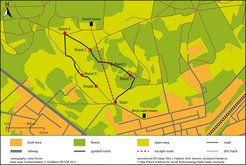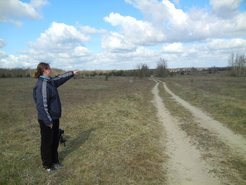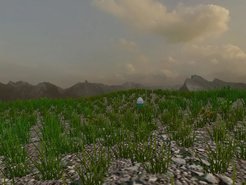Brainscapes
Investigating how differences in environmental layout influence the neural topography of spatial navigation
Pilot study (2011-2012)
Conducted with the support of MaxNet Cognition
Participants
Prof. Günther Schlee (Head of the project)
Prof. Robert Turner (Head of the project)
Kirill Istomin (Principal Investigator)
Juan F. Domínguez (Principal Investigator)
Gary F. Egan (Principal Investigator)
Joachim Otto Habeck (Research Assistant)
Jaroslava Panáková (Research Assistant)
Denis Kostylev (Programmer)
Theoretical background
People vary in the degree to which they rely on two basic navigational strategies. One strategy makes use of explicit memory of spatial relations between known landmarks – the so-called cognitive or mental map. The other strategy involves behavioural responses (i.e., turns or continuing movement straight ahead) to chains of stimuli specifying certain routes – so-called route knowledge. Individuals differ significantly in their relative mastery of one or the other strategy and studies have shown that they may systematically prefer one over the other. People also have a tendency to learn spatial information specific to one of the navigational strategies at the expense of that specific to the other strategy. Furthermore, long-term reliance on one or the other strategy has been shown to lead to structural changes in the brain.
Little is known about the factors involved in the formation of individual preferences for navigational strategies. However, it is rather likely that at least some of these factors are group-specific (i. e. they affect groups rather than individuals) and, therefore, they are likely to lead to group-specific differences in navigation and spatial learning style. Thus, it has been convincingly argued that the effectiveness and the very applicability of the two navigational and learning strategies essentially depend on the type of environment, with mental mapping being more effective in environments with unrestricted vistas and a limited number of distant landmarks (such as a steppe or a desert) and the strategy of route following being more effective in environments with restricted vistas and a considerable number of close-up landmarks (such as a dense forest). Other factors may include the experience in navigation, the peculiarities of navigational tasks themselves, and the means of travelling. All these are likely to depend on profession, social status and way of life and, therefore, to be group-specific as well. Finally, a large range of possible social and cultural factors, which are particularly difficult to investigate by usual laboratory methods, can be suggested to determine group-specific differences in navigational and spatial learning styles.
The predisposition to deploy one strategy more often than the other are likely to have pronounced behavioural and cognitive consequences for two reasons. First, the two strategies support and limit navigation in different ways: the route knowledge strategy seems to be more straightforward and lead to fewer errors in navigation; the mental map strategy, despite being more prone to errors, allows the possibility to calculate and take new and potentially more efficient routes to the target. Second, the changes in brain structures associated with a particular navigational and spatial learning style can have effects on other cognitive abilities and, therefore, on other brain regions. These effects, if present in groups, are likely to have social and cultural consequences. Therefore, an evaluation of the distribution of spatial navigation and learning styles between groups as well as of factors contributing to their formation would be an important contribution to both neuroscience and a range of social disciplines. Although such an assessment lies outside the main focus of research in all these disciplines, it is a suitable task for neuroanthropology, a new field of study that integrates theory and methods from anthropology and neuroscience to investigate the ways in which culture and the brain interact.
Aims of the project
Brainscapes is a neuroanthropological project that aims to establish if group differences in navigation and spatial learning styles associated with detectable structural and functional traits of the brain really exist and, if they do, what impact they have on behavioural patterns of the members of the group. The pilot stage of the project focuses on one particular factor described in the previous section – the type of the environment of usual navigation – and attempts to check if this factor reliably causes a particular navigation and spatial learning style associated with detectable brain changes in an experienced navigator. In other words, our pilot study seeks to answer the following two research questions:
1) Does long-term experience of navigation in a particular type of environment (as characterized by the size of vista and number of distant and close landmarks) reliably produce preference for either mental map or route knowledge strategy of navigation and spatial learning in an individual?
2) Does the preference of an experienced navigator for a specific strategy of navigation reliably cause detectable functional and structural changes in one or several regions of his/her brain?
The positive answers to these research questions would mean that group-specific differences in navigational styles and the corresponding differences in brain structure and function should exist. These differences and their socially significant behavioural and cognitive consequences can, therefore, be investigated in the framework of a larger research project.
Approach

The Brainscapes project plans to innovatively combine ethnographic fieldwork methods with behavioural experiments and brain imaging techniques. This will involve the integration of ethnographic material regarding navigational strategies across cultural groups inhabiting distinct landscapes; ethnographic data collection; behavioural tests; and techniques of data gathering and analysis from cognitive and behavioural neuroscience. The pilot study in particular consists of three stages:
Stage 1: Screening process. The screening stage will involve an ethnographic interview in order to obtain details of the type of environment in which prospective participants grew up, their familiarity with it and their experience navigating it.
Stage 2: Behavioural investigation. In this stage, a subsample of participants from the screening stage will be administered a set of navigational tasks. . Both the quantitative and qualitative data on their performance during the realization of these tasks will be collected in order to diagnose their preference for and mastery of each of the two navigational strategies.
Stage 3: Brain imaging. In stage three, five people with way-finding preference and five people with route-following preference from stage two will be invited to take part in a brain imaging experiment where functional and structural pictures of their brains will be taken. Participants will be allowed to explore and learn two new virtual environments, one of them being open-vista, the other being closed-vista type. They will then be given several localization tasks in these environments to perform during functional MRI scanning.
Expected results

The Brainscapes project has been developed in cooperation by the Max Planck Institute for Social Anthropology, the Max Planck Institute for Cognitive and Brain Sciences, and the Monash Biomedical Imaging Laboratory (Monash University, Melbourne, Australia). The project is being realized jointly by researchers from these three institutes.
The greatest contribution of this project, starting with the pilot study, will be the opening of a new avenue of inquiry for the three institutes involved: the relationship between brain and cultural experience. This is an important research frontier in the study of the human condition: to understand how culture and society shape the human brain, the implications of this for the operation of the human mind, and how a mind, being the product of this process, in turn changes and shapes culture and society. While still in its infancy, research on this question is already under way and there is conclusive evidence that culture has a determinant role in brain function and structure. The present project represents the first attempt by a research team of anthropologists, cognitive scientists and neuroscientists to delve into this issue.
Besides that, Brainscapes may have important implications for clinical interventions aimed at treating dysfunction in navigational competence due to damage to the hippocampus or caudate nucleus. It has been suggested, for example, that patients whose preferred navigational strategy has been disrupted as a result of insult to the relevant underlying brain structure could benefit from intervention programs that help them shift to the intact navigational system. It can be suggested, furthermore, that the training and consistent use of wayfinding strategies may help prevent hippocampal degeneration caused either by usual processes of aging or pathologically, by Alzheimer’s or Huntington’s diseases (for which low gray matter in the hippocampus is a risk factor). If, as we predict, preference for one or the other navigational style is influenced by environmental layout, clinical treatment and prevention of navigational dysfunction could be improved by exposing patients to (real or virtual) landscapes with features that would best elicit the desired strategy. This could also be applied more broadly to the training of professionals facing navigation challenges in different environments.



